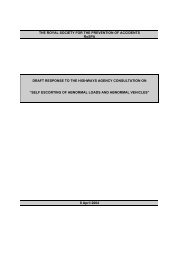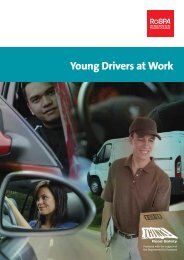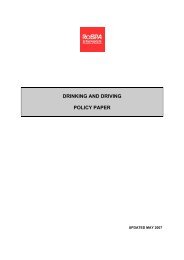Travel training - Key Stages 3 and 4 - RoSPA
Travel training - Key Stages 3 and 4 - RoSPA
Travel training - Key Stages 3 and 4 - RoSPA
Create successful ePaper yourself
Turn your PDF publications into a flip-book with our unique Google optimized e-Paper software.
Section 4 – Cycling<br />
St<strong>and</strong> out from the crowd<br />
It is extremely important that other road users are aware<br />
of you when you are cycling. You should take care to ensure<br />
that you are clearly visible at all times.<br />
Fluorescent<br />
When cycling in daylight, wear bright or fluorescent colours.<br />
Orange <strong>and</strong> yellow are the most conspicuous.<br />
Reflective<br />
At night reflective material will help to keep you safe.<br />
Reflective material is designed to shine light back to its<br />
source <strong>and</strong> is only effective in the dark.<br />
Before you go<br />
Give your bike the ABC check<br />
l Air – check your tyres are at the correct pressure<br />
l Brakes – make sure these are working<br />
l Chain – not to tight or too loose<br />
If you ride at night, your bike must have<br />
l a white front light<br />
l a red rear light<br />
l a red rear reflector.<br />
Lights must be kept clean <strong>and</strong> unobscured. It is dangerous<br />
<strong>and</strong> illegal to ride in the dark without lights.<br />
For greater safety it should also be fitted with<br />
l amber pedal reflectors<br />
l a white front reflector<br />
l white or amber wheel reflectors<br />
Plan your route<br />
Fluorescent <strong>and</strong> reflective materials come in a wide range of<br />
products from larger items like jackets <strong>and</strong> vests to smaller<br />
accessories like badges <strong>and</strong> clip-ons that can be attached<br />
to your clothing or bag. The most noticeable clothing is a<br />
fluorescent jacket with b<strong>and</strong>s of reflective material round<br />
the sleeves <strong>and</strong> body.<br />
It is a good idea to plan where you are going. Routes with<br />
heavy traffic <strong>and</strong> busy roundabouts can make cycling<br />
particularly hazardous <strong>and</strong> unpleasant. See if your local<br />
council or local cycle groups produce maps of good cycle<br />
routes. Try to find routes with quieter roads, cycle lanes<br />
<strong>and</strong> cycle crossings. Experiment with a number of different<br />
routes to find the best one for you. The shortest route is not<br />
necessarily the best route. Remember that you should enjoy<br />
your cycling.<br />
29

















